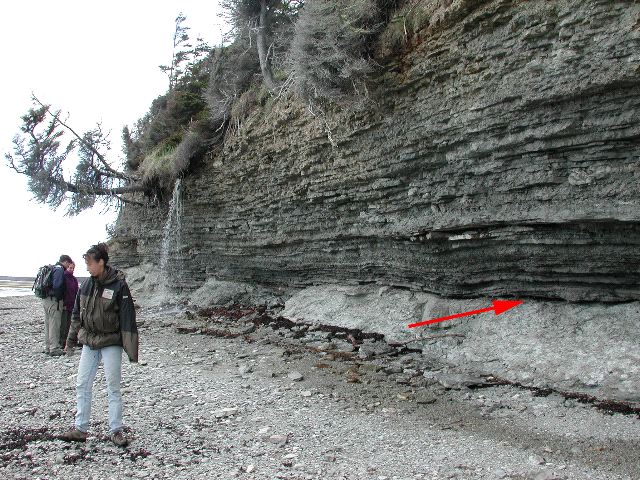Life in crisis

 (112 kb) In fact, the appearance and disappearance of various species and entire groups of animals define many of the divisions in the geologic record. It is estimated that present-day biodiversity represents only 1% of the total number of species that ever lived on the planet, which means that 99% of species have disappeared at one time or another.
(112 kb) In fact, the appearance and disappearance of various species and entire groups of animals define many of the divisions in the geologic record. It is estimated that present-day biodiversity represents only 1% of the total number of species that ever lived on the planet, which means that 99% of species have disappeared at one time or another.The Phanerozoic Era, which began around 540 million years ago, left us a bountiful fossil record. The evidence in this record reveals that Phanerozoic time was marked by many extinction phenomena, with five of those events each affecting more than 60% of existing species. These events also represent the best documented extinctions.

 (44 kb)The first coincided with a severe ice age at the end of the Ordovician Period. Examples of afflicted contemporary animals are found in the Percé region of Quebec, and the rock sequence on Anticosti Island in the Gulf of Saint Lawrence is one the best in the world for documenting the recovery of animals at the beginning of the Silurian, just after the extinction.
(44 kb)The first coincided with a severe ice age at the end of the Ordovician Period. Examples of afflicted contemporary animals are found in the Percé region of Quebec, and the rock sequence on Anticosti Island in the Gulf of Saint Lawrence is one the best in the world for documenting the recovery of animals at the beginning of the Silurian, just after the extinction.The second event occurred during the Upper Devonian, shortly after the creation of Miguasha, and its effects were particularly harsh on aquatic life. Reefal communities disappeared, including brachiopods and trilobites, and many fish groups were also affected.
The ichtyofauna represented at Miguasha offers a remarkable view of the diversity achieved by vertebrates just before this second great extinction, which lasted several million years at the beginning of the Famennian Age.
The end of the Permian Period marked the third of these events and the greatest crisis in the history of life on Earth when 95% of the planet’s species rapidly disappeared.
Forty million years later, at the end of the Triassic Period, the fourth event was characterized by the disappearance of many members of the dinosaur group, whereas in the sea, animals like ammonites and nautiluses were particularly affected.
The extinction that led to the disappearance of the dinosaurs in a general slaughter at the end of the Cretaceous is the most famous of the five extinctions because it was caused by the impact of a giant meteorite, a phenomenon that readily captures the imagination of the general public. The planet was essentially set afire and then surrounded by a veil of ashes that blocked out sunlight, provoking extreme changes to the climate accompanied by corrosive acid rain! Along with dinosaurs, almost all shallow-water marine life, a large portion of terrestrial plants, and all large animals disappeared.
Small mammals, protected by their burrows, were able to survive and profited from the newly vacated ecological niches, rapidly evolving in different directions to eventually attain their present day diversity.
Great catastrophes are often cited to explain great extinctions. Those that occurred at the end of the Ordovician and Cretaceous are the best understood. The Triassic extinction, like the Cretaceous event, was possibly caused by a meteorite impact, whereas the substantial increase in volcanic activity at the end of the Permian was likely a source of that crisis. But the causes of extinctions are multiple and not yet well understood. The upheavals that affected communities at the end of the Devonian are an excellent example of the complexities involved.
Changes to the climate and large-scale biotopes have become increasingly noticeable during these early years of the 21st century, and some say that they will lead to the next episode of severe extinctions. Nevertheless, the Earth’s fossil record has taught us that life is stubborn and has readjusted time and time again when faced with major upheavals.
Site map | Feedback | Links | Sources | Credits
Life in crisis
<< A Devonian day | The Late Devonian extinction event >>

Title: The Ordovician-Silurian boundary at Anticosti
Author: Parc national de Miguasha
Sources: Parc national de Miguasha
Year: 2002
Description:
The Anticosti rock sequence in the Gulf of Saint-Lawrence displays a continuous series of sedimentary rocks that overlap the Ordovician-Silurian time boundary, indicated here by an arrow. The ice age at the end of the Ordovician Period had a harsh impact on the fauna living at that time.

Title: Massive extinctions
Author: François Bienvenue
Sources: Parc national de Miguasha
Year: 2007
Description:
Five massive extinctions of life are thoroughly documented in the history of earth. The fauna of Miguasha offers a window into the world of vertebrates just before the extinction at the end of the Devonian.


